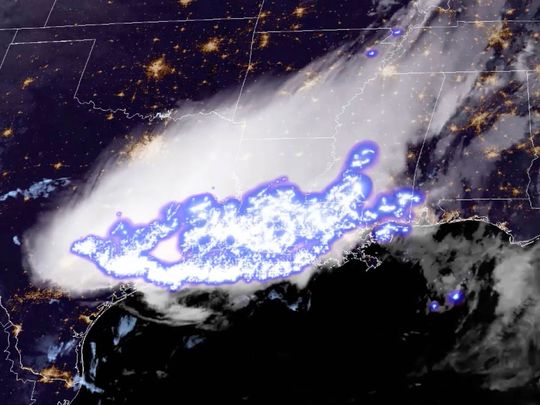
Geneva: One flash in the United States almost two years ago cut the sky for almost 770 kilometers, regulating a new world record, the UN said Tuesday.
A new record for the longest Megaflash detected, measured in the South AS on 29 April 2020, stretched 768 full kilometers, or 477.2 miles, in Mississippi, Louisiana and Texas.
It is equivalent to the distance between New York City and Columbus, Ohio, or between London and the German city of Hamburg, the United Nations Meteorological Organization (WMO) shows in a statement.
Lightning Bolt Zig-Zagged is about 60 kilometers further than the previous record, regulated in South Brazil on October 31, 2018.
The WMO expert committee about the weather and extreme climate also reported a new world record during the duration of flash lightning.
One Flash that developed continuously through lightning storm over Uruguay and North Argentina on June 18, 2020 lasted 17.1 seconds – 0.37 seconds longer than previously set on March 4, 2019, also in North Argentina.
– ‘even bigger extreme’ –
“This is an extraordinary note of a single flash lightning event,” Randall Cerveny, Rapporur WMO weather and extreme climate, said in the statement.
“Extreme environment is a measurement of life from natural forces, as well as scientific progress to be able to conduct such an assessment,” he said.
The technology used to detect the length and the duration of flashes of lightning has increased dramatically in recent years, allowing far greater records than the norm.
The previous “Megaflash” recording, from 2018 and 2019, was the first time verified with new satellite lightning imaging technology and both of them more than double previous records using data collected from land-based technology.
“It’s likely that even larger extremes still exist, and that we will be able to observe it as a lightning detection technology increasing,” said Cerveny.
WMO highlighted that a new recording attack took place in the Great Plains in North America and La Plata Basin in South America, known as a hotspot for what was called a mesoscale convective storm system (MCS), which allowed Megaflash.
Pressing it that the flash that regulates new records is not isolated events, but occurs during an active and large-scale storm, making them more dangerous.
“Lightning is a big danger that claims many lives every year,” said the Head of WMO Peter Talas in the statement.
“These findings highlight public lightning safety issues that are important for electrical clouds where flash can travel a very large distance.”
WMO shows that the only safe location is a large building with wired and plumbing, or a vehicle sprung up fully closed metal.
The UN agency maintains official global records for climate-related weather and statistical range, including temperature, rainfall and wind.
All records are stored in the WMO Weather and Extreme Climate Archives.
The current archive includes two other extremes related to other lightning.
One of them was for most people who were killed by one flash strike, when 21 people died in Zimbabwe in 1975 when they gathered for safety in the huts that were beaten.
The others were for indirect strikes, when 469 people died in Dronka, Egypt when lightning crashed into a set of oil tanks in 1994, causing burning oil to flood the city.


